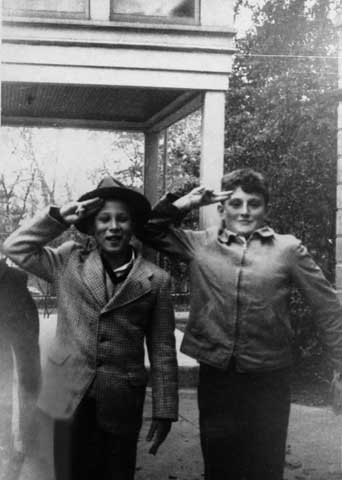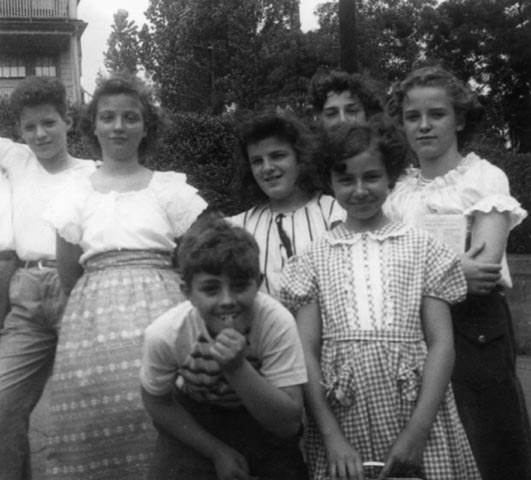Passover

| MAX HARRY GASS AND ADELE KORFF GASS: A LIFE TOGETHER Passover |
|
Pesach (Passover)[1], which commemorates the deliverance of the Hebrew people from Egyptian slavery, was a very special time in the Gass household. Adele described Passover in her home:
“Pesach was the most demanding of the Jewish holidays and I used to dread it each year because it was so much work. To commemorate the deliverance of the Hebrew people from Egyptian slavery, the Bible requires that we retell the story of the exodus, remember that once we were slaves in Egypt, and eliminate all hametz [foods that are fermented or can cause fermentation] from the diet and from the home. Wheat, barley, spelt, rye, and oats, and anything made from these grains are hametz except for matzah. In addition the use of utensils—plates, cutlery, pots, pans, etc.—that came into contact with hametz is forbidden unless they are koshered for Passover. This total elimination of hametz serves as a reminder that the fleeing Hebrews lacked the time to allow dough to rise before baking it.
“Max watched over me to make sure I complied with the Biblical commandments. Max didn't take any short cuts when it came to following Jewish law. Everything in the entire house had to be spotless—rugs, furniture, closets, drawers—everything! I had a separate set of dishes special for Passover that I pulled out each year, but we still needed to kasher [make kosher] other items for Passover. This was usually accomplished by immersing the items in boiling water.
“I removed the shelves from the refrigerator, washed the refrigerator thoroughly, and then I washed it again with baking soda and lined the shelves with aluminum foil. I cleaned the burners of the stove, immersed them in boiling water and then wiped them clean. For the inside of the oven I used Easy Off oven cleaner and then I wash it down with baking soda. It was a lot of work.
“I packed up all my everyday dishes and washed all my cupboards. I had a closed-in porch and I had cabinets built on it. I transferred everything from my inside cabinets to the outside ones. Then I had room for my Passover groceries. After Passover I transferred the outside items back inside.
“For Passover use, I owned two sets of dishes for twelve, plus glasses, utensils, and silverware. These were dishes for flayshig [meat]. We always held big sedars on the first and second nights of Passover with as many as 35 to 60 people, including guests who were not Jewish. We only had a few dishes and cutlery for milchig [dairy] meals for our immediate family to get through the week.
“The night before the first sedar, Max conducted a search called Bedikat Hametz. There was a special blessing before the search began in which we thanked G-d for commanding us to remove the hametz. Max went from room to room with a candle looking for hametz.. I had placed breadcrumbs on the windowsills and he would sweep them off with a feather into a bag. We bundled up the crumbs and the next day we took them to the rabbi. He burned them in an oven and marked down our name.
“My father always wore a kippel [special robe] to the sedar. Sometimes Max wore a kippel, too, but at other times he wore a diner jacket or suit and tie. I made Max a kishn, a special cushion to recline on during the sedar. [Reclining at meals is a symbol of freedom.] We used to have a long Haggadah but I bought a shorter version because the kids got restless. Max didn't like that. Regardless of how we rushed him, we didn't get through the sedar until 11:00. He just went on and on and on, especially if he had participants who were interested. I would urge him to read faster, and he would, but he would break to tell stories. Max would have preferred to finish at midnight or later. My father's sedars lasted until three in the morning.
“I made my own charoset using sweet red wine, Macintosh apples, walnuts, and a little bit on cinnamon. I used to put the ingredients through the grinder to make a paste. I also used to grate my own horseradish but later I bought the bottled white kind. When the children opened the door for Elijah, Max took a sip of wine from Elijah's Cup. Max wasn't a big drinker so he didn't empty the goblet. When Max ransomed the afikomon, all the children got a little gift or money evenly divided.
“At the end of Passover I packed away the
Passover dishes and unpacked my every day ones. Max wouldn't let me buy bread
the night Passover ended because he felt it wasn't kosher if it was baked
during Passover.”
Sukkot
Adele described her family's observance of Sukkot.[2]
“When the kids were younger Max would make Kiddish in the sukkah at the temple during Sukkot. We had a sukkah at home but Max didn't think it was kosher enough because the roof was solid, and the stars weren't visible through it. Years ago in my father's house, we placed the sukkah on the side of the house. It was enormous! A lot of the people took literally the Biblical commandment, 'You shall live in booths,' and so they slept in it even though it sometimes became quite cold at night and rained. Max and I didn't sleep in our sukkah.
“At the home of Max's parents, the porch on the second floor became a sukkah. It was kind of like a room with a roof that moved.”
Max was always the first in the synagogue to place his order for the etrog [citron] and the lulav—a green bouquet consisting of the lulav [palm branch], three hadasim, [myrtle branches], and two aravot [willow branches]. These items are ancient symbols of the harvest and are used in a ritual blessing inside the sukkah. The lulav, hadasim, and aravot are tied together in a holder made from palm leaves. Inside the sukkah the lulav bouquet is held in the right hand, the etrog is held in the left, and a special blessing is recited. Then the lulav is waved by pointing it in six different directions and shaking it each time to symbolize G-d's presence everywhere. Max always brought home his etrog and lulav except on the Sabbath when he left them at the synagogue.
As American as Apple Pie
|
|
|
During World War II, Adele made time to volunteer for the Red Cross as a truck driver. She drove trucks, an ambulance, and even a motorcycle for the Red Cross. In this photo, she is being honored for her participation. Paul remembered a small benefit of his mother’s prowess behind the wheel. One time a large truck was blocking the road and the truck driver was nowhere in sight. So to the astonishment of Paul, Adele got out of their car and moved drove the truck out of her way. |
|
|
 |
| Like father, like son. In some ways, Max and Paul were similar. Max Gass (left) gives an army salute during World War I; (right) Paul saluting on the left with an unidentified friend during World War II. |
|
|
|
Max and Adele also integrated American traditions into their household, including huge birthday parties with lots of friends and family. At this birthday party for Janet, Janet and Paul are standing at the back of the table, flanked on the left by Aunt Anna Gass Shapiro and their father, and on the right by their grandmother Lena Kessel Gass, their mother, and Aunt Minnie Gass Alter. Jay is standing (or sitting) directly in front of Lena. |
|
|
 |
|
Paul (right) with a friend; (right photo) Friends of Paul and Janet |
|
|
|
|
Paul, back row 3rd from right and his classmates |
[1] Passover is observed for eight days, except in Israel where it is observed for seven. The highlight is the sedar, where the Exodus story is retold through a sequence of prayers, readings, activities, songs, and feasting outlined in a book called the Haggadah. A sedar plate holding symbolic Passover foods is placed on the holiday table. These foods are (1) Maror--bitter herbs (usually horseradish)— symbolize the bitter lives of the Hebrew slaves in Egypt. (2) Charoset--a mixture of fruit and nuts--is a reminder of the mortar the Israelites made for their masters. (3) Zero'a--shankbone (usually a roasted lamb bone)--symbolizes the paschal lamb eaten on Passover by the Hebrews when the Temple stood in Jerusalem. (4) Karpas--a green vegetable that is dipped in salt water--suggests springtime and rebirth. (5) Baytza--roasted egg--represents the sacrifices brought to the Temple at festival times. (6)Chazeret--lettuce, radish or another bitter vegetable--symbolizes the bitterness of slavery.
Three pieces of matzah are placed on the sedar table. Two of the pieces depict the loaves of challah placed on the Sabbath or festival table. The third represents the Passover holiday. During the sedar the leader breaks off a piece of the middle matzah and hides it. The children hunt for it later and ransom it for a gift. This matzah is known as the afikomon (Greek for desert) and is the last food eaten at the sedar meal.
A goblet filled with wine is also placed on the table. It is Elijah's cup, a symbol of hope that the prophet Elijah, the harbinger of the Messiah, will appear that night and usher in the Messianic age.
[2] Sukkot, the Festival of Booths, is one of three Pilgrim Festivals. Passover and Shavuot are the others. It is celebrated for seven days (although some people have an eight-day celebration). In ancient times Jews traveled to Jerusalem by foot to celebrate the holiday. They brought a portion of their fall crops to give to the priests. Some of the offering was used as a sacrifice at the Temple, the rest was kept by the priests to feed their families.
The sukkah, the primary symbol of Sukkot, is a temporary dwelling, a reminder of the shelter Jews slept in while wandering in the wilderness after fleeing Egypt. Sukkahs are also reminiscent of the huts the Israelites constructed near their fields at harvest time.
Contemporary sukkahs can be made from a variety of materials--wood, plastic, canvas, etc. The main requirement is that the roof be sufficiently dense to provide more shade than sunlight during the day but not dense enough to obscure starlight at night.